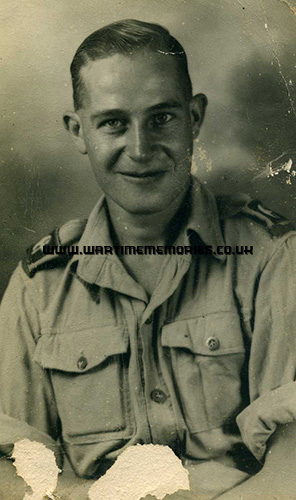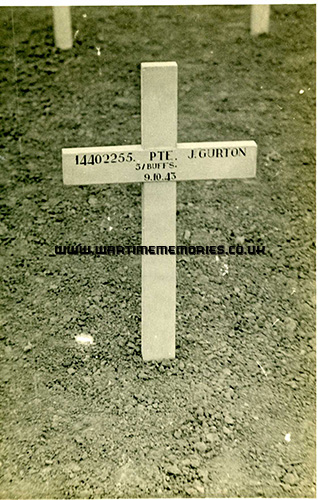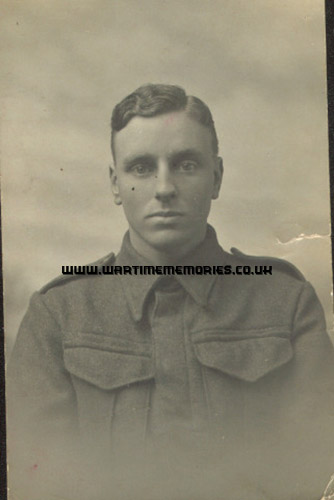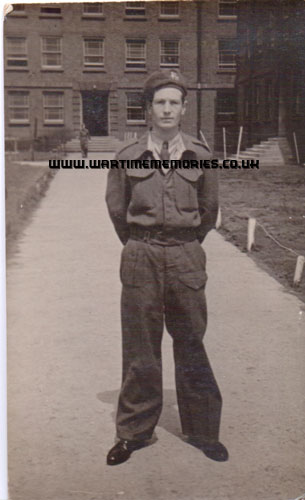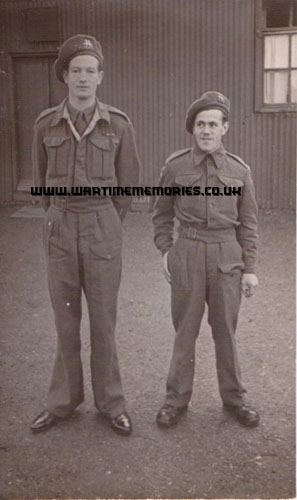William Henry Donald Overy 5th Btn. Royal East Kent Regiment
Bill Overy was in the British Army, serving with the 5th Buffs, an East Kent Regiment. He joined the Territorials on the 3rd May 1939 when he was 24 and in April 1940 he went to France. In May they took up positions along the Arras-Doullens road to defend the town of Doullens. They had no backup troops to their rear or any aircraft for support. They had three Bren guns for which there had been little training and three 0.55 inch anti-tank rifles and one 2 inch mortar which unfortunately had no ammunition. All this to stem the onslaught of the 218 tanks of the 6th Panzer division, which overrun them on the 20 May 1940 and he was captured.
Following his capture they were all herded into a field with thousands of others of all nationalities where they stayed for about 3 or 4 days. When they moved off they received a black loaf, about 9 inches long, to share between six of them. They marched on for days often raiding empty houses to get food and wine to go with the turnips they collected from the fields.
Eventually they arrived at a railway siding, where they were loaded into cattle trucks, 40 to a truck, with no ventilation, except for a narrow window about a foot square. They traveled for days through Luxembourg. Germany and Poland some days they ate and some days they didn't.
They arrived at Thorne in Poland to Prisoner of War camp Stalag XXA which was a large fort but the
food was still bad consisting of one litre of watery soup at mid day and at tea time a loaf between
five of them and ersatz coffee made from acorns.
About 20 men all from the Buffs, were sent to DANZIG in EAST PRUSSIA to work on farms and from
there they were allowed to write a card home every two weeks.
By Christmas 1940 they were moved to Stalag XXB at MARIENBURG in EAST PRUSSIA. It was very cold
and the snow was deep and with no greatcoats it was very bad but for Christmas they had their
first Red Cross parcels. They returned to Stalag XXA in the spring and then in the summer of
1941 moved to a new camp outside Thorne.
Parcels started to arrive from the Red Cross and from home, so what with these and they
exchanged coffee, tea and chocolate with the Poles for white bread, eggs and cakes, life was fair.
They got the bread and eggs past the guards by making pockets inside the lining of their coats
and dropped the eggs down inside. They had concerts at night in the camp, also football,
a lot of the players were professionals from big clubs back home in Britain. Every Sunday
they had a church service.
In the spring of 1942 they were put on a farm work party in the village of GRUSSAUS GR SCHONWALDE
near GROUDENS. They lived in a large house with two Polish families and the farmer and his wife
and two children.
They were split up into pairs to go onto the farms and the guards took them out at 6 in the morning
and returned for them at 6 at night. A lot of things changed, they gave the women tea and coffee and
showed them how to brew tea.
The women did their washing, for which they paid them with soap, chocolate or cigarettes from their food
parcels.
Bill Overy made friends with John Whitticker from Derby who was the camp barber and they shared their
Red Cross parcels so they went a lot further. They would often meet prisoners from other farms
and exchanged news, much was wild rumors but it helped to keep up their moral.

During this time there was a new arrival, which was always a great event as they always had more news.
He was Jack Imlack, a New Zealander who had been captured in Crete and was from camp Stalag XXB.
He had been in a lot of trouble because he hated the Germans and one night a guard hit him with his
rifle, so he hit him back and broke his jaw.
For this he got 8 months in a civil jail and it nearly killed him, he was 16 1/2 stone when he
went in and 8 stone when he came out. They took him in with them sharing their food parcels.
In the spring of 1944 they got hold of an old radio that they kept under the floorboards.
Every morning two were left behind to clean the rooms while the guards took the rest to work.
This gave them the opportunity to listen to the British news and write it down.
When they delivered the milk later they would pass on the news to other areas.
So came the great day, 6th June 1944. Bill Overy was one doing the cleaning that morning and when
they put the radio they found out the Allies had landed in France. They could not believe it and
as luck would have it, they did not write it down or pass it on they just could not believe it.
When they got back to the fields they told the others, forgetting some of the Poles had learnt
a bit of English.
By that night the entire village knew. Of course the guards didn't know, they were not told until two
days later, so where did the news come from? Their rooms were turned upside down but they found
nothing and the Poles kept quiet. Later that week three of them were returned to Stalag XXA
with their corporal. When the corporal was being interrogated they heard all he said
from the next room so they were all able to tell the same story. They said they
had heard the officer in charge of the guard talking about it. That was that,
they went back to Schonwalde and the officer went to the Russian front.
All mail from home stopped from July 1944 and food parcels came only one a month,
so their food had to be rationed. Winter came and in November it started to snow
and the temperature was 20 degrees below zero.

Early in 1945 they were told they would be leaving at the weekend and they would be walking.
So they got rid of all excess baggage, except food, their spare shoes and clothes they gave to the Poles.
The three of them made a sledge to carry their food and on the Saturday they left, pulling their
sledge, to a camp called Possen.
The journey there was not too bad, plenty of snow but at night the guards found them shelter in a
barn, as there was only twelve of them. Food was a problem though as their food parcels were very low.
It took four days to reach the camp that was an assembly area for all the working parties in the area.
They stayed for two days waiting for everyone to arrive then they each were given two Red Cross
parcels and they loaded their sledge and started on their way. There were about 400 British
and 200 Russians and 25 guards and 6 dogs.
The German officer rode in a small buggy pulled by two horses. They had a short rest every two hours,
which was not too bad at the beginning but then some started to lag behind. The Germans turned
their sledges over and hit them with their rifles and made them leave everything. One night they
spent in the open in a football ground, and in the morning they left quite a few behind frozen
in the snow. Even if they sheltered in a barn, they never took their boots off as they would
freeze solid and it would be impossible to put them on again.
As food became scarce the Germans killed some horses to make soup and at one of the place they
caught a rabbit, which they killed and ate raw.
The snow was nearly gone by the time they arrived in STETTEN and crossed the river into
Germany but it was still very cold and the rain meant they slept in wet clothes at night.
At this point they left the Russians behind.
Days did not seem to matter anymore. Walking, walking and more walking. One day they
arrived at a farm where there were about 200 British POWs, they were in a terrible state
with dysentery and typhus and they were dying like flies. The guards were scared stiff
so they quickly moved them on.
The Germans started to get trigger-happy and two lads were shot trying to pick up potatoes
and another when he relieved himself during the night.
And still they walked on, first one way, then another, until they reached the town of CELLE.
In HAMBURG they were put into huts near the station. That night the station was bombed but
none of them were killed. The guards did not know where go, so they started to take them
south into Germany while the sound of gunfire got closer. At this point Bill, John and
Jack thought they had had enough so they planned to make a break for it when they moved off.
After about an hour they dived into a wood but the Germans sent the dogs after them and they
were recaptured.
John had been hit around the head with a rifle that split his ear and when they next stopped,
they were trying a bit of first aid when the British NCO, in charge, told them the guards had gone.
So at last they were free, after 5 years. The change that came over them was unbelievable.
Where it had been every man for himself, now those who had cigarettes shared with everybody else.
It was a wonderful feeling.
Of the 400 who had started out on the march, less that 200 were left. Not all had died,
a lot had been taken into hospital on the way but it was still a shock.
They were told to tidy up and were soon busy shaving and washing, as best as they could.
The NCO's went to look around and when they returned they said the Americans were down the
road and as they were still in the British Army would march into town.
Then they were taken by truck to the British main depot at a place called Hereford about 4 hours
drive away and then to Munster and flown to Brussels. That night in Brussels they went to the
Churchill Club for their first taste of English beer in five years. The next day they boarded
another Lancaster for England and home.






